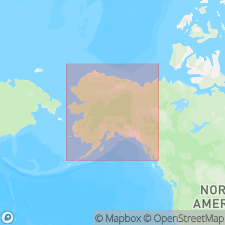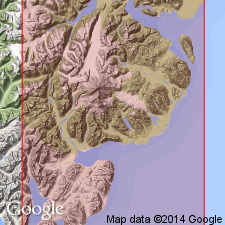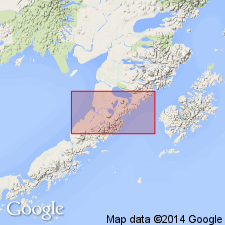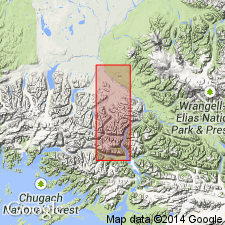
- Usage in publication:
-
- Talkeetna formation*
- Modifications:
-
- Named
- Biostratigraphic dating
- Dominant lithology:
-
- Volcanics
- Breccia
- Tuff
- Sandstone
- Shale
- AAPG geologic province:
-
- Alaska Southern region
Martin, G.C., 1926, Mesozoic stratigraphy of Alaska: U.S. Geological Survey Bulletin, 776, 493 p.
Summary:
Named for exposures in eastern Talkeetna Mountains, southern AK. Also occurs in Matanuska Valley and adjacent areas. Includes lava, agglomerate, breccia, and tuff, interbedded with lesser volumes of sandstone and shale. Is probably several 1000 ft thick. Basal contact was not observed. Unit underlies Tuxedni sandstone of Middle Jurassic age. Contains plants which are oldest Jurassic known in North America (F.H. Knowlton). Invertebrates suggest Early Jurassic age according to T.W. Stanton.
Source: GNU records (USGS DDS-6; Menlo GNULEX).

- Usage in publication:
-
- Talkeetna Formation*
- Modifications:
-
- Areal extent
- Revised
- AAPG geologic province:
-
- Alaska Southern region
- Alaska Southwestern region
Summary:
Geographically extended into west side of Cook Inlet. Subdivided into (oldest to youngest): Marsh Creek Breccia Member, Portage Creek Agglomerate Member, and Horn Mountain Tuff Member (all new). Members and Talkeetna Formation (undivided) shown on geologic map of Iniskin-Tuxedni region. Age is Early Jurassic.
Source: Modified from GNU records (USGS DDS-6; Menlo GNULEX).

- Usage in publication:
-
- Talkeetna Formation*
- Modifications:
-
- Areal extent
- AAPG geologic province:
-
- Alaska Southwestern region
Summary:
Talkeetna Formation extended into Puale Bay area (Karluk quad) since volcaniclastic sedimentary and volcanic rocks here are lithologically similar to Talkeetna Formation in Talkeetna Mountains and Cook Inlet. Age is Early Jurassic.
Source: GNU records (USGS DDS-6; Menlo GNULEX).

- Usage in publication:
-
- Talkeetna Formation*
- Modifications:
-
- Age modified
- Biostratigraphic dating
- AAPG geologic province:
-
- Alaska Southern region
Summary:
Age in area of report (northern Chugach Mountains and southern Copper River basin) is regarded as Late Triassic(?) and Early Jurassic. Local age based on Early Jurassic marine megafauna from most of unit in Peninsular terrane and Late Triassic fossils in presumably correlative strata (Pogibshi unit of Kelley, 1983 [OF-84-152]) in southern Kenai Peninsula.
Source: GNU records (USGS DDS-6; Menlo GNULEX).
For more information, please contact Nancy Stamm, Geologic Names Committee Secretary.
Asterisk (*) indicates published by U.S. Geological Survey authors.
"No current usage" (†) implies that a name has been abandoned or has fallen into disuse. Former usage and, if known, replacement name given in parentheses ( ).
Slash (/) indicates name conflicts with nomenclatural guidelines (CSN, 1933; ACSN, 1961, 1970; NACSN, 1983, 2005, 2021). May be explained within brackets ([ ]).

